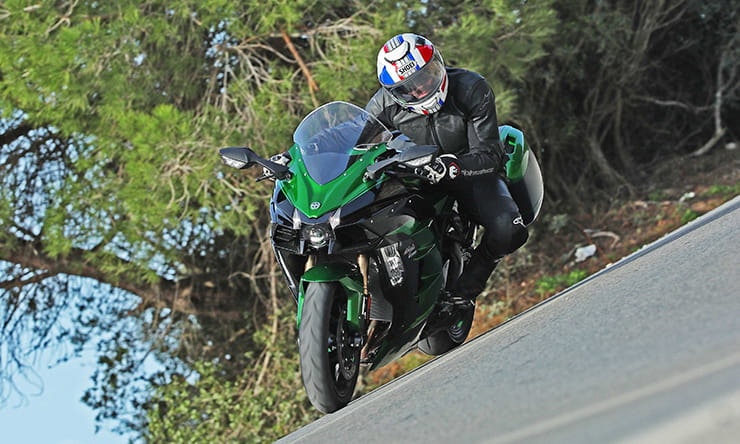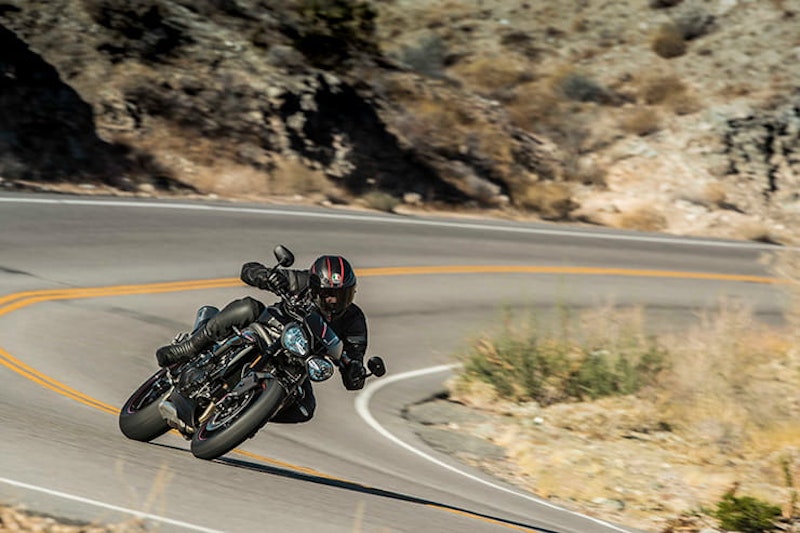Your expert
Crispin d’Albertanson is a Nurburgring coach, senior IAM observer and ex-endurance racer who now works with the well-respected Hopp Rider Training. You can book a course on road or track at www.hoppridertraining.co.uk or 07881 878989
Eyes parallel to the horizon, arms bent, outside knee locked onto the tank… he’s ready to tip it in
I thought I just sat on the bike. So, what should I be doing?
The riding position basics are to keep your upper body slightly leant forward so you’re in a semi-crouch, even if you’re on an adventure bike. Then make sure you’ve got a good bend in your arms so you can react to hazards quickly (lots of sportsbike riders don’t do this) and finally keep the balls of your feet on the pegs. That’s the basic position to work from.
What about my head? Should that stay in line with my shoulders?
No. I see a lot of riders doing this, keeping their head in line with their body going through corners rather than their neck being relaxed and their eyes staying level with the horizon. Some racers such as Colin Edwards manage to ride using this technique, but the people I see aren’t trying to emulate him. Instead, they’re tense and are not looking through the corner properly.
If you’re used to riding with straight arms, this position is going to seem very alien. But it’s worth persevering - you’ll feel more in control and look like you’re on it
Why is head position important?
Because it’s a heavy part of the body, so leaning your torso and head towards the inside of a corner can make a big difference - you won’t have to lean the bike over as far. But also, by maintaining a clear horizon, you keep your vision clearer and are better able to tell how far you’re leaning. And when you’re looking for the exit, turn your head rather than just moving your eyes - this gives you a wider, clearer view of where you want to go.
What about weighting the pegs. Worth doing?
It’s better to think of it as pressure rather than weight - you exert pressure on the outside peg to push your leg up against the tank as you approach a corner. This locks your lower body in position, creating an anchor point. Then you bend in the middle, leaning forward and into the corner without putting any weight through the bars. It should feel like your top half is almost collapsing forward, your core muscles taking the strain while your arms relax, your forearms staying parallel to the road. That should give you the perfect position.
So if I’m going into a right hand bend I apply pressure to the left footpeg?
Yes. You’re effectively holding on to the bike with your left leg. You can then steer the bike by pushing with your right arm - pushing right to go right. You can do this while maintaining a very gentle touch on the bars. A lot of the riders who I see hanging off are literally doing that - hanging their weight off the bars. This means they can’t steer properly and the bike can’t turn as it’s designed to.
Ignore Versys man, check out the guy behind. His arms are only slightly bent and his upper body is almost upright so his wrists are pushing down through the bars, not forward. He won’t be able to turn the bike fast like that. Compare him with the bloke on the BMW.
Is it easy to sort out body position?
No. Changing your body position is one of the most difficult challenges you’ll face as a rider. A tiny adjustment will feel very, very odd. But keep going - a solid riding position is one of the foundations for safe, fast riding.
Share on social media:

